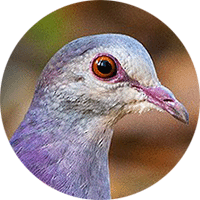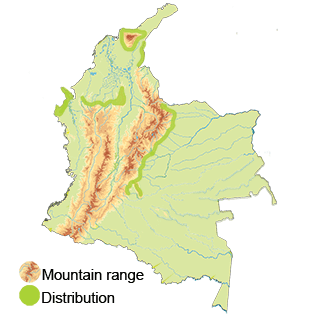Violaceous Quail-dove
The Violaceous Quail-dove (Geotrygon violacea). Read in Spanish
Appearance: The Violaceous Quail-dove is a medium-sized, colorful dove with distinct plumage. It has a rich purple or violet neck, chest, and belly, a contrasting white throat, and a reddish-brown back. The bird has a short, rounded tail and red eyes.
Habitat: The Violaceous Quail-dove inhabits dense tropical forests, especially in hilly or mountainous regions. In Colombia, they can be found in humid forests, cloud forests, and forested areas along slopes and foothills.
Behavior: These doves are shy and elusive birds that forage on the forest floor for seeds, fruits, and insects. They are typically solitary or found in pairs. When disturbed, they prefer to walk or run rather than fly, but they are strong fliers when needed.
Breeding: The Violaceous Quail-dove builds a simple nest of twigs and leaves in low vegetation, where the female usually lays one white egg. Both parents share the incubation and care of the young.
Conservation Status: The Violaceous Quail-dove is generally considered to be of least concern in terms of conservation status globally.
Distribution
The Violaceous Quail-dove (Geotrygon violacea) is a bird species found in various regions of Colombia. Here is a breakdown of the distribution by region in Colombia for the Violaceous Quail-dove:
1. **Andean Region**: The Violaceous Quail-dove can be found in the Andean region of Colombia, which includes two Andean mountain ranges: the Eastern and Central Andes. These birds inhabit montane forests, cloud forests, and dense undergrowth in the Andean foothills and mountains.
Chocó Region: The Chocó region of Colombia, located along the Pacific coast, is another area where the Violaceous Quail-dove can be found. The humid forests of the Chocó region provide important habitat for a variety of bird species, including the Violaceous Quail-dove.
Sierra Nevada de Santa Marta: The Violaceous Quail-dove can also be found in the Sierra Nevada de Santa Marta, a mountain range located in northern Colombia. This region is known for its high biodiversity and unique ecosystems, making it an important habitat for various bird species, including the Violaceous Quail-dove.
Taxonomy
The Violaceous Quail-dove (Geotrygon violacea)
- Kingdom: Animalia
- Phylum: Chordata
- Class: Aves (Birds)
- Order: Columbiformes
- Family: Columbidae
- Genus: Geotrygon
- Species: Geotrygon violacea
Vocalization
The Violaceous Quail-dove (Geotrygon violacea)
- Song: The song of the Violaceous Quail-dove is a soft, mournful series of whistling coos that are often repeated in a rhythmic pattern. The sound is melodious and carries well through the forested habitats where these doves are commonly found.
- Call: In addition to their song, Violaceous Quail-doves produce various calls for different purposes. Their calls can vary from soft, gentle coos to louder, more abrupt sounds. These calls are used for communication with other doves, establishing territories, or expressing alarm.
- Territorial Calls: Male Violaceous Quail-doves often use vocalizations to defend their territories and attract mates. Their calls can serve as a means of signaling their presence to other males and announcing their territory to potential rivals.
- Courtship Calls: During the breeding season, Violaceous Quail-doves engage in courtship displays that involve vocalizations. These calls are used to attract potential mates and establish pair bonds. The male may perform elaborate calls and displays to court the female.
- Alarm Calls: When threatened or alarmed, the Violaceous Quail-dove may emit sharp, rapid calls or louder, more urgent sounds to alert others in their group of potential danger. These alarm calls help the doves in the group to take evasive action and protect themselves.




